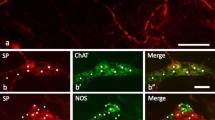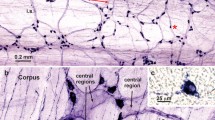Abstract
The enteric nervous system (ENS) of the mammalian gut consists principally of two ganglionated plexuses, the myenteric and submucous, which are embedded in the gut wall1. Little is known about the anatomical and functional connections between the two plexuses and further clarification of their relationship is of central importance for the understanding of the ENS. In the present study we have approached this problem in a new way, using methods we have previously developed for maintaining the myenteric and submucous plexuses separately in vitro for several weeks2,3. In an immunohistochemical study of these preparations and also of sections from normal and extrinsically denervated gut wall, we have found evidence for reciprocal projections between the myenteric and submucous plexuses, by nerve fibres containing two putative neurotransmitters, vasoactive intestinal polypeptide (VIP)4 and substance P (ref. 5) (see Fig. 1). Our observations were supported by radioimmunoassay of tissue extracts. These results suggest that one of the roles of these peptides in the gut is to coordinate the function of the two enteric plexuses.
Similar content being viewed by others
References
Gabella, G. Structure of the Autonomic Nervous System (Chapman and Hall, London, 1976).
Jessen, K. R., McConnell, J. D., Purves, R. D., Burnstock, G. & Chamley-Campbell, J. Brain Res. 152, 573–579 (1978).
Jessen, K. R. et al. (in preparation).
Larsson, L. I. et al. Proc. natn. Acad. Sci. U.S.A. 73, 3197–3200 (1976).
Franco, R., Costa, M. & Furness, J. B. Naunyn-Schmiedeberg's Arch. Pharmac. 306, 195–201 (1979).
Schultzberg, M. et al. Brain Res. 155, 239–248 (1978).
Hökfelt, T. et al. in Psychopharmacology: A Generation of Progress (eds Lipton, M. A., Di Mascio, A. Killam, K. F.) 39–66 (Raven, New York, 1978).
Costa, M., Patel, Y., Furness, J. B. & Arimura, A. Neurosci. Lett., 6, 215–222 (1977).
Mitchell, S. J. & Bloom, S. R. Gut 19, 1043–1048 (1978).
Cavazzana, P. & Borsetto, P. L. Acta Anat. 5, 17–41 (1974).
Hirst, G. D. S. & McKirdy, H. C. J. Physiol., Lond. 369–385 (1975).
Jessen, K. R. et al. Gastroenterology 76, 1161 (1979).
Jessen, K. R. et al. (in preparation).
Coons, A. H., Leduc, E. H. & Connolly, J. M. J. exp. Med. 103, 49–60 (1955).
Pearse, A. G. E. & Polak, J. M. Histochem. J. 7, 179–186 (1975).
Author information
Authors and Affiliations
Rights and permissions
About this article
Cite this article
Jessen, K., Polak, J., Noorden, S. et al. Peptide-containing neurones connect the two ganglionated plexuses of the enteric nervous system. Nature 283, 391–393 (1980). https://doi.org/10.1038/283391a0
Received:
Accepted:
Issue Date:
DOI: https://doi.org/10.1038/283391a0
- Springer Nature Limited
This article is cited by
-
Localisation and activation of the neurokinin 1 receptor in the enteric nervous system of the mouse distal colon
Cell and Tissue Research (2014)
-
Alterations in the distributory pattern of vasoactive intestinal polypeptide immunoreactivity in the ischemic intestines of dogs
Medical Electron Microscopy (1994)
-
Physiology and pathophysiology of colonic motor activity
Digestive Diseases and Sciences (1991)
-
A pharmacological and immunohistochemical study of the splanchnic innervation of ileal longitudinal muscle in the toad Bufo marinus
Naunyn-Schmiedeberg's Archives of Pharmacology (1986)
-
Comparative distribution of vasoactive intestinal polypeptide (VIP), substance P and PHI in the enteric sphincters of the cat
Experientia (1984)





